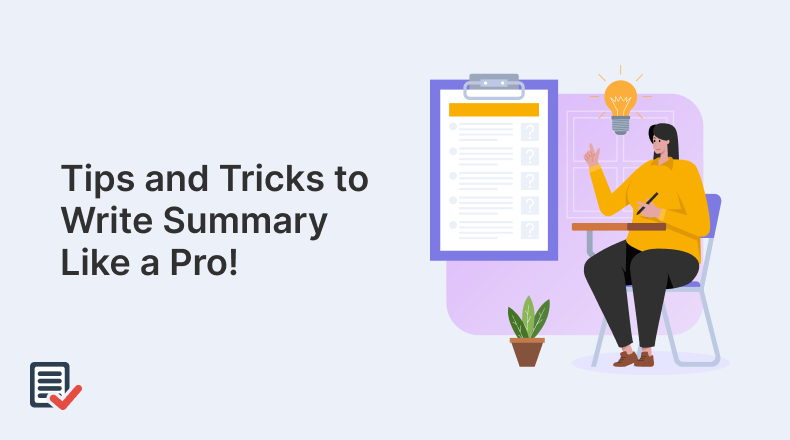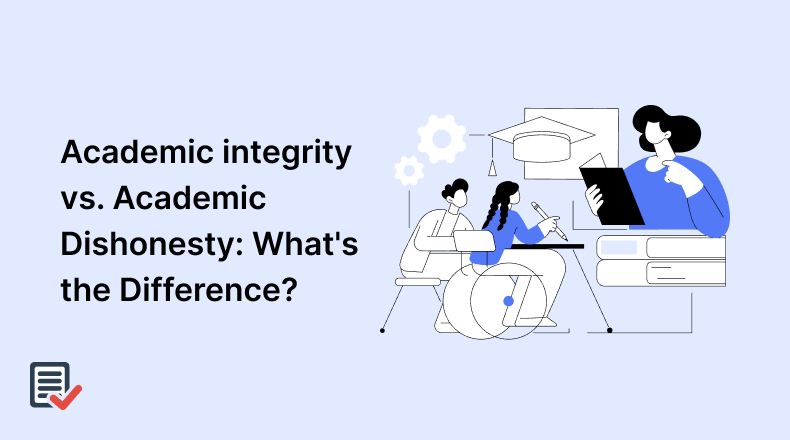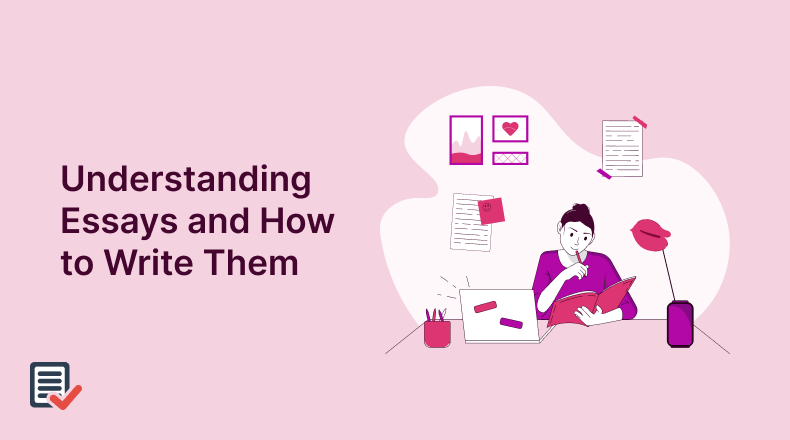
There’s a lot more to essays than just the stereotypical impression of a dreaded assignment. Contrary to what a lot of people (especially schoolkids) may know or think, essays aren’t just some sort of boring two-page papers written on topics like “My Favorite Teacher” or “My First Pet”.
Writing essays is a whole art. There are different varieties of essays, and there are different rules and regulations that you have to follow when writing them. If you start doing some research about essay writing, you could get a little overwhelmed with all the stuff that you’d find.
But don’t worry. In this guide, we’re going to start at the bottom by looking at what essays are, what types they’re divided into, how they’re written and so on. We’ll break our discussion up into parts so that it’s easy for you to go through them.
Essays: What Are They?
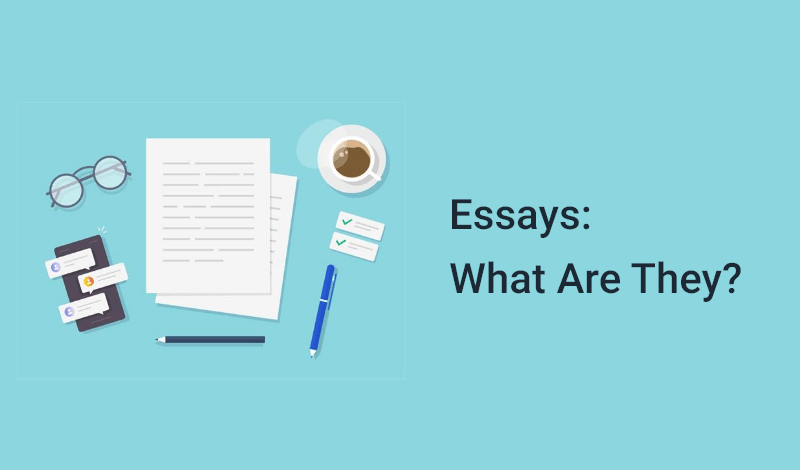
To start off our guide, let’s take a look at what essays actually are.
If you take to the internet for a definition for the word ‘essay’, there are a couple of different ones you can find. However, if we want to describe the meaning of the word in simple terms, we can say that:
“An essay is a short piece of writing on a particular subject.”
On some online sources, you can find words like: “…an essay is a piece of writing conveying the author’s perspective or viewpoint…” But, this definition falls apart if we were to consider narrative essays. Narrative essays can be, far from being a perspective or viewpoint on a subject, merely an account or an experience given by the author.
Similarly, some sources could explain essays as a piece of writing written to persuade the reader. Once again, this definition won’t hold true for narrative and descriptive essays since both of these can be written for explanatory and illustrative purposes.
Considering the above, we can appreciate that the basic definition i.e., the one given in the quotes is the best for describing what an essay is.
Essays: Types
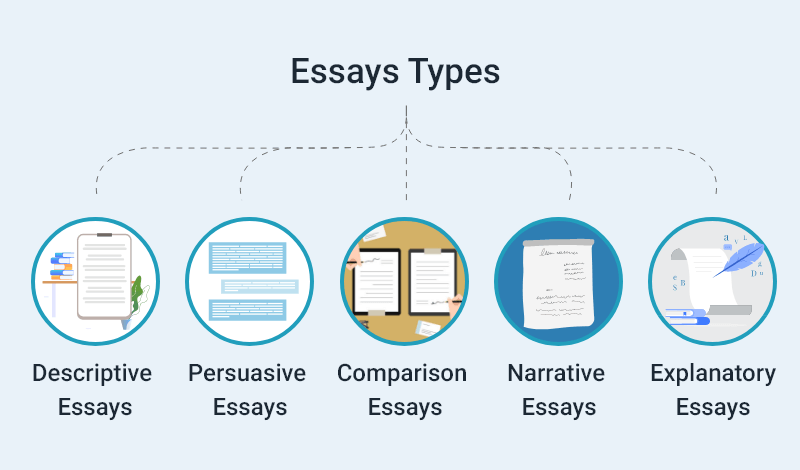
We did bring up some stuff about narrative and descriptive essays in the heading above. Those two are basically types of essays, and there are a bunch of others besides them as well. And that is what we’re going to be talking about now.
When it comes to the types of essays, there isn’t a set of standard and universally accepted ones that we can list here. If you happen to do some research online, you’ll find that various sources have their own lists of essay types. Some of them divide the types into five different ones whereas some go to ten.
In our opinion, the types of essays can be adequately explained by the following classification:
- Descriptive Essays
- Persuasive Essays
- Comparison Essays
- Narrative Essays
- Explanatory Essays
Let’s look at each of these types in some detail.
1: Descriptive Essays
Descriptive essays are the type of essays that are written for the purpose of describing, depicting and defining a particular idea, object, person or place. These types of essays are characterized by their cold, third-person approach. In other words, they don’t carry a personal bias nor are they written for the purpose of proving a point or argument.
Here are some topics on which a descriptive essay can be written:
- My School
- My City
- The First Potato That I Grew in a Flower Pot in the Shed on My Uncle’s Farm
- The Computer
- The Light Bulb
- The Weird Person Standing Behind My Desk
And so on.
Incidentally, most of the essays that are assigned to schoolkids in lower grades are of the descriptive type.
2: Persuasive Essays
Persuasive essays are essays that are written for the purpose of making the reader believe in a certain idea or notion, or for the purpose of making them accept one’s perspective on the same.
Contrary to descriptive essays, persuasive essays are driven by a strong personal bias and are centered around one’s own ideas or viewpoint on a certain subject.
Here are some topics on which persuasive essays can be written:
- Should Plagiarism Be Allowed?
- Should There Be Uniforms for Private Offices?
- Should Accidental Plagiarism Be Penalized?
- Can You Eat Boiled Potatoes with Cream and Sugar?
Descriptive essays are usually assigned to students of high school or college level. This is not a fixed rule, though.
3: Comparison Essays (AKA “Compare and Contrast” Essays)
Comparison essays can be defined as the type of essays that are written for the purpose of comparing two or more objects, persons, ideas, or concepts.
When it comes to writing comparison essays, the presence of a personal bias depends on the topic at hand. If the topic requires the person to prove or support a certain thing or person over the other, then the comparison will be tilted and prejudiced. And the nature of such an essay will, by the way, somewhat overlap with that of persuasive essays since it will involve favoring one thing over the other.
But, if the topic does not demand the student or writer to favor any of the involved parties or elements, then a bias should not and will not exist.
Here are some examples of comparison essays:
- Freelancing vs Working Full-Time
- Academic Writing and Copywriting: The Differences
- Peanut Butter and Jam: The Better Choice
4: Narrative Essays
A narrative essay is an essay that contains a first-person account given by the author about a certain experience or condition.
Narrative essays are written from the author’s perspective, and they are more or less a type of story.
These types of essays are usually assigned to school kids from around the 1st grade to the 6th or 7th. Some examples of narrative essay topics include:
- My Trip to the Park
- My First Visit to the Dentist
- My Trip to Walmart
And so on.
5: Explanatory Essays
Explanatory essays are defined as essays that are written for the purpose of explaining any specific object, idea, or event. Explanatory essays are somewhat similar to descriptive essays. But, the latter is written for describing whereas the former is for explaining.
When writing an explanatory essay, the author has to go into detail about the topic at hand, and they have to properly dissect it. These types of essays usually involve a number of different headings, sub-headings, sections etc.
Here are some topics on which explanatory essays can be written:
- Why Do Students Procrastinate?
- What Makes Academic Writing Different Than Normal Content?
- What Has Technology Changed in the World of Education?
Essays Have Some Parts…
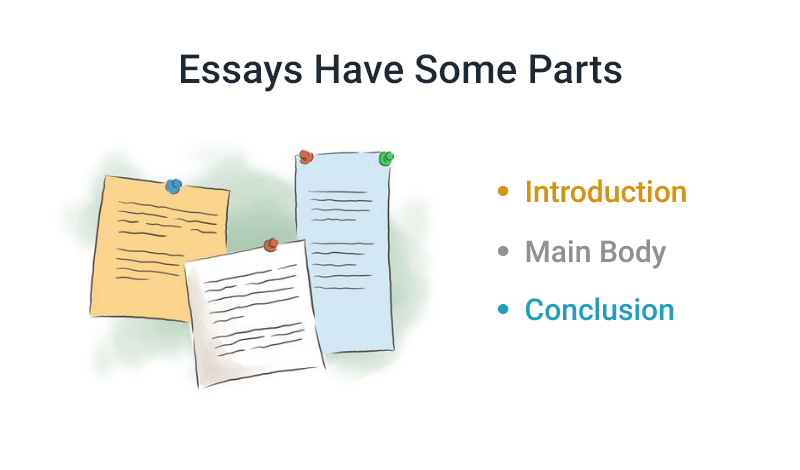
When defining the word ‘essays’, we did merely suffice by calling them “a short piece of writing on a particular subject”. This means that any short piece of writing on a particular subject will qualify as an essay…provided that it is not categorically defined as something else.
Nevertheless, there are some parts and components that usually and traditionally exist in essays. Even if the parts are not highlighted and properly defined, there is a certain pattern that appears in almost every one of them.
Here are some parts that you can typically find in an essay:
- Introduction
- Main Body
- Conclusion
In the Introduction, the topic is introduced with some general information that helps in setting the ground for the discussion in the main body. As we said, in some essays, the introduction will be written properly under a special heading. In others, while there won’t be a special heading, the starting couple of paragraphs will serve the same purpose.
The introduction is usually written about 5% or 10% of the whole text. If you are writing an essay spread out over 1,000 words, the introduction will be around 50 to 100 words.
In the Main Body, the topic is discussed in earnest. If the essay happens to be an argumentative one, then the main body is where all the arguments and evidence will be compiled along with the necessary explanations.
One thing to remember is that even if there are several smaller sub-headings and sections making up the essay, they are all classified as the main body (except for the intro and the conclusion). In other words, the main body does not need to be a big chunk of text. Everything, other than the introduction, conclusion and references part is the main body of the essay.
The Conclusion is the part where the discussion is wrapped up and the essay is brought to a close. In a lot of cases, the conclusion simply recaps the points mentioned in the main body.
Essay Writing is Fun!
Once you get the hang of it, writing an essay is fun and enjoyable. An essay is where you can let your creativity loose and write what you want however you want it. But, for people who don’t know how to write it, the whole thing can look daunting and intimidating.
Don’t worry though. In this part of our guide, we’re going to be highlighting the steps that you can follow to easily write an essay. We’ll break the process up into parts so that you can easily go through them without getting confused.
There are basically three main phases into which the essay-writing process can be divided. They are:
- The Research Phase
- The Writing Phase
- The Proofreading and Editing Phase
1. The Research Phase
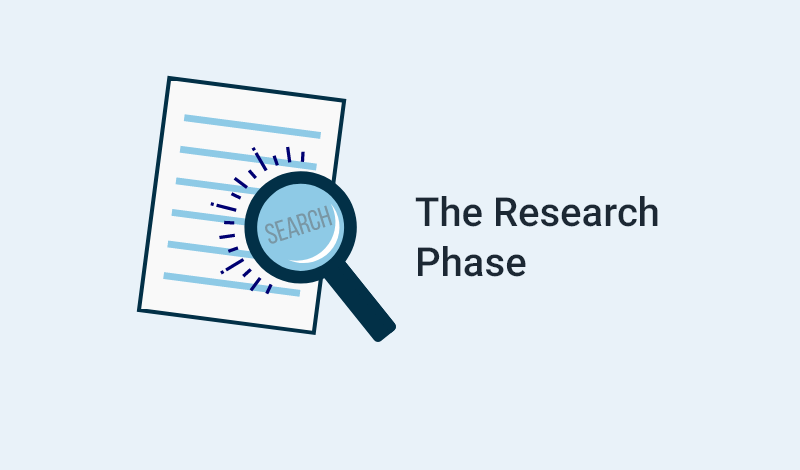
The quality of an essay depends largely on the type and amount of research you do before it. To write a good essay, you need to do some good research first.
When doing your research, there are two things that you have to be careful of i.e., where you do it and how you do it.
Where to Conduct Essay Research?
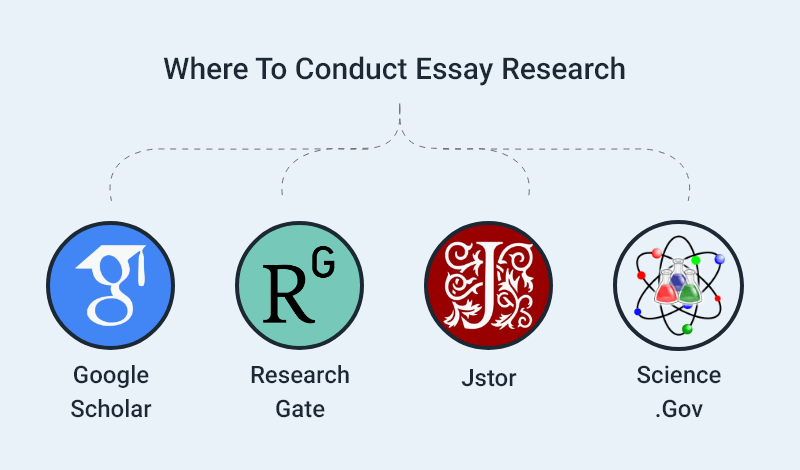
As far as the ‘where’ goes, you have to take care to find and select reliable sources. And by reliable, we refer to the ones that are considered academically credible.
Let’s actually cite an example here to show what we mean.
Wikipedia is a popular platform. In May 2022, the total number of annual visitors clocked in at 5.1 billion. Everyone uses it.
But…
It’s not academically reliable. Institutions don’t regard it as a referable source, and they may actually penalize the student who cites it in their papers.
The purpose of this example was to simply highlight the fact that when it comes to determining the reliability of a source, popularity is not the deciding factor. Using a popular source for getting general information to use in your essay is fine. But, if you want to cite a specific fact or figure, you have to use a website or a journal that is acknowledged and recognized as dependable.
Keeping the above in mind, some platforms that you can use for your research include:
- Google Scholar
- ResearchGate
- JSTOR
- Science.gov
And so on.
When choosing a source for doing your research, you also have to take into consideration the guidelines chalked out by your institute. If there is a website that is normally considered to be perfectly reliable, but it is prohibited by your institute, then you cannot use it.
How to Conduct Essay Research?
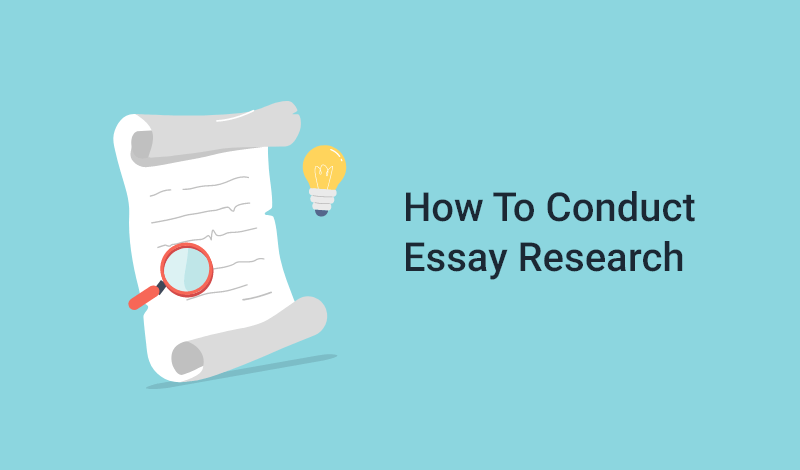
That goes as far as where the research should be done. Now, let’s move on to the how part.
The first thing that you have to be careful about is not to focus on or favor a particular source over others. This is a rookie mistake that even some experienced people can make.
If you favor or focus on a single source, there are a lot of chances for you to commit accidental plagiarism. Even if you don’t actively take some content directly from that particular source, you can mimic their words and style without realizing it.
Plus, even to your readers, your write-up will visibly appear to be influenced by a specific source, especially if the latter happens to be well-known.
So, whenever you want to take information for your essay, always take it from different places.
Another thing that you should be careful about when conducting research is not to directly take something from a source in the exact words. When you want to take an idea or a concept from an existing essay or research paper, write it down as a short note. Then, when the time comes to explain it, do it in your own words.
The third and final thing that you should keep in mind when doing research is to keep track of the facts and figures, and their respective sources. By keeping track of your sources as well as the facts and figures that you tool from each one, you will be able to create your citations easily, when the need arises.
2. The Writing Phase
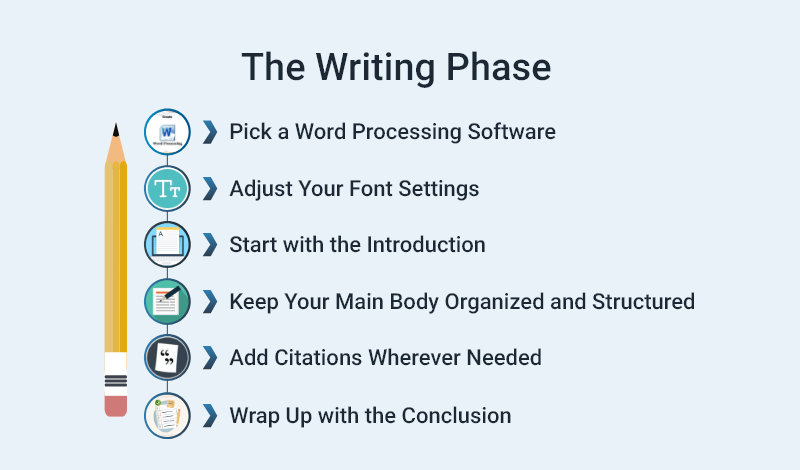
After the research comes the part with the actual writing. Unlike the last part, we won’t be looking at this one in phases. That’ll get a little bit confusing. We’ll do steps instead.
Step 1. Pick a Word Processing Software
We’re going to assume that you’re using a computer for writing your essay.
So, the first thing that you need to do is find a good word processing software. To be fair, there aren’t a lot of options out there that you can get confused with. As far as word processing software go, the duopoly is mainly held by MS Word and Google Docs. There are a couple of other slightly popular ones as well…such as WPS and LibreOffice.
Your aim, when choosing a word processing software, should be to pick one that provides the features and options that you need for writing your essay. For example, if you want to write an essay, you’ll be fine using a software that allows you to select from multiple heading styles, add bullets, add hyperlinks, shrink and enlarge text size, change font color, change the text orientation and so on.
We aren’t going to advocate picking a specific platform or tool over the other. You just have to go with one that provides the required features and that you’re comfortable using.
Step 2. Adjust Your Font Settings
The next thing that you have to do is adjust your font settings. These are mostly given by institutions according to their own guidelines. But normally, academic papers have to be written in “Times New Roman” font with size “12”.
Other than this, if there are any other requirements given by your institute, such as the margins and the line spacing, you will also have to set them in this step. The same goes for the color of the font.
Step 3. Start with the Introduction
After all this preamble, you have to start writing the actual essay.
As we mentioned earlier, there are usually three different parts to an essay. The first one is the introduction.
When writing the introduction, you have to basically describe the main theme and topic of the essay. You can do this by giving talking about some general facts about the topic or by presenting some sort of not-very-specific but relevant pieces of information.
For example, if you’re going to write an essay on technology and how it has affected the education sector, you can start off with some words like:
“Technology has taken the world by storm, revolutionizing industries left, right and center…”
After starting out like this, you can slowly bring the context down to the exact topic at hand, after which you can properly broach it in the main body.
Step 4. Keep Your Main Body Organized and Structured
Then, after the introduction, you have to get started with the main body.
When writing the main body, you have to take care not to merge or scatter the points and arguments. In other words, you have to talk about the different points and arguments in your essay one by one.
Some writers can have the habit of digressing from their actual point to explain another one or leaving one point to discuss a completely different one. While this is something fine and acceptable in informal writing, it’s not at all advisable in an essay.
If the essay you’re writing is an explanatory or descriptive one, you have to keep the different aspects and elements under different headings. If you want to divide a heading into further subheadings, you can follow the good old “1.1” and “1.2” styles. If you want to go even further, you can start with “1.1.2” or “1.2.4” and so on.
Structuring your essays like this i.e., using headings, subheadings, section headings and bullets help to make it easy to peruse.
Step 5. Add Citations Wherever Needed
As you write the main body, always add citations wherever they are needed. That is, whenever you take any sort of fact or figure from a source, add a citation there and then. If you delay this for later, there are chances that you could cite the wrong source or enter some wrong details in the references. This could amount to source-based plagiarism, which could further elicit a penalty.
The best way to go about citing your sources in this manner is to use a citation generator. When the citation generator gives out the in-text citation and the reference, you can simply copy-paste the former into your essay while pasting the latter into a separate document.
Then, after you’re done with the essay, you can paste the other document at the end under a header titled “References”.
Step 6. Wrap Up with the Conclusion
After you’re done with the main body, you have to wrap your essay up with a conclusion. Length and nature-wise, the conclusion is quite similar to the introduction.
It has to be around 5% to 10% of the entire essay and it has to succinctly summarize the material discussed in the same. The text summarizer can assist you in summarizing the essay effectively as it uses AI technology in order to understand the context and selection of key points within it.
Depending on the essay you’re writing, the conclusion could also look better if it is written as a verdict or a decision rather than just a summary of the main body. For example, if you’re writing a compare and contrast essay, then the conclusion should talk about which one of the discussed items/persons/places/situations is better than the other(s) and for what reasons.
3. The Proofreading and Editing Phase
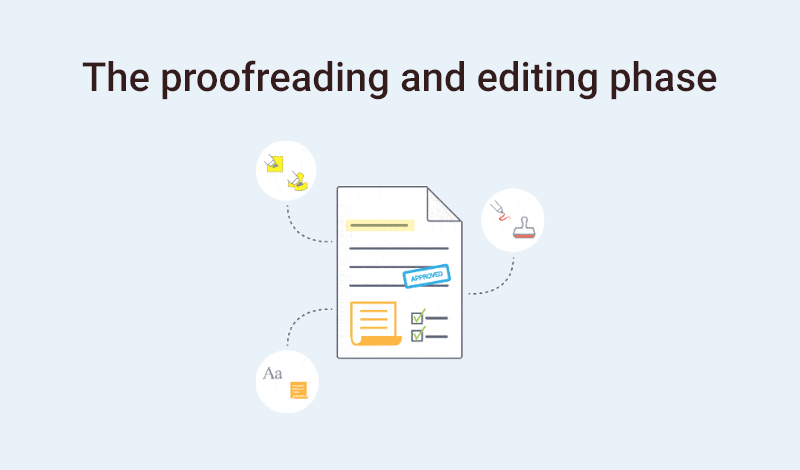
With the conclusion, your writing phase will come to an end. But, while the writing part is done, your essay is far from being finished. You have to proofread and edit it before you can finalize it for submission.
There are a couple of different things that you have to do during this phase. We’ll discuss them all one by one.
a. Finding and Removing Grammar Errors
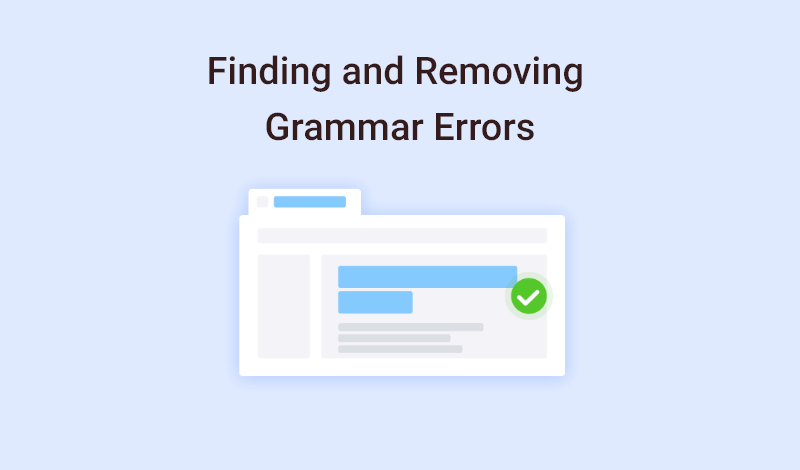
This is your first priority in the editing phase. Before finalizing your essay, you have to make sure that there are no grammar errors or spelling errors in it. Even though these types of errors are natural and are committed by everyone, they don’t reflect nicely on the quality of your essay.
To find and remove these errors, there are two things that you have to do:
- Proofread the text manually two or three times
- Run the entire essay through a reliable online grammar-checking tool
When you want to proofread your essay, don’t do it instantly after you’re done writing it. Rather, give it a couple of hours and then come back to it.
The benefit of waiting before proofreading is that you’re able to somewhat forget what you’ve written. That way, you can look at the text more objectively and easily find the errors.
On the other hand, when you want to run your essay through a reliable grammar checker, you just have to be careful to pick the right tool.
b. Finding and Eliminating Plagiarism
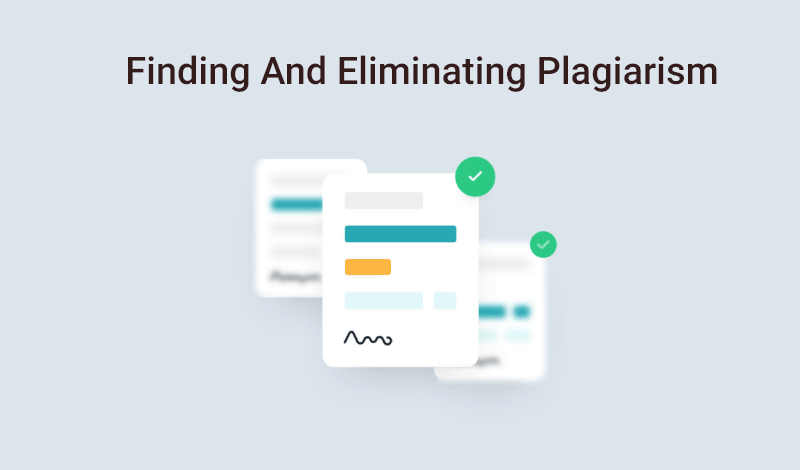
Plagiarism is the worst thing that can come in your essay. If the percentage of plagiarism in your write-up exceeds the tolerated limit (which is usually specified by the institute), it can waste your whole effort.
That is why the next thing that you have to do in the editing phase is to find and get rid of plagiarism.
To detect plagiarism, you have to use a dedicated plagiarism checker. There are quite a few of these available on the internet, and you can take your pick as per your need and requirement.
Then, after you use the tool to find plagiarism, you have to take the necessary steps to eliminate it. There are a couple of different steps that you can take for this purpose. You can either reword the plagiarized parts, remove them altogether, or put them in quotation marks.
Experts Explain Tips on Writing an Authoritative Essay
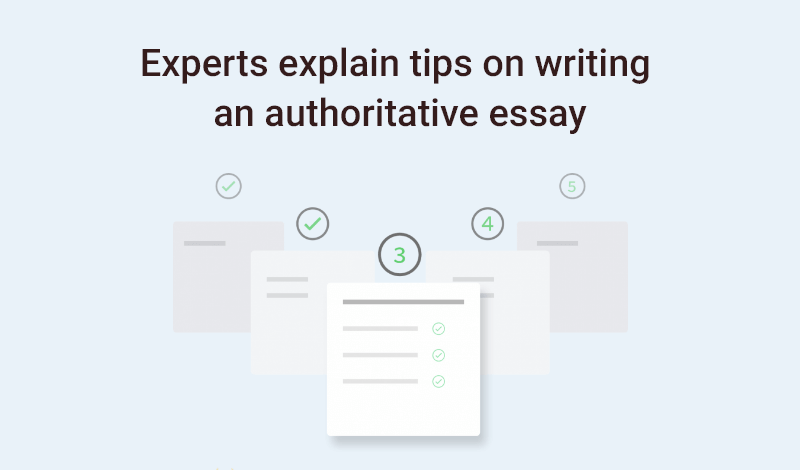
The method that we’ve mentioned above is the basic set of steps that you can follow to write an essay. However, there is a lot of stuff that you can take care of when following the steps to make your essay look authoritative.
For the next part of this guide, that is what we’re going to be looking at. We’ll be going over some tips that you can follow during the essay-writing process to make your work look nice and professional.
1. Take Inspiration, Not Content
This is a good tip that you can implement when doing research for your essay.
During the research phase, you should take inspiration from the sources and not just leech off their content. A good way to do this is to take short notes about each of the points that you want to include in your essay, and then explain them in your own words.
Let’s explain that a bit better.
Take an example. Suppose you’re writing an essay about octopuses. When researching, you come across the following sentences in a source:
“Octopuses possess a remarkable regenerative ability, which allows them to grow their arms back should one of them get severed. This is, incidentally, something they can do intentionally as a defensive mechanism to throw off predators.”
Now, instead of using these sentences as is in your own essay, you can simply make a note like “…explain the regenerative process of octopuses and their arm-detachment defensive mechanism…” Then, when writing the essay, you can elaborate on this note in your own words and completely steer away from committing accidental plagiarism. This will, in turn, make your essay more authoritative.
2. Pause Between the Three Phases
In the step-wise guide given above, we divided the essay-writing process into three phases i.e., the research, writing and editing/proofreading.
If you want to be thorough with your essay, you should always keep some intervals between these three phases. For example, when you do your research, you should make your research notes and record the names of the sources (for citations), and then leave the whole thing for a while. After a couple of hours, you should come back and get started with the writing.
Then, after the writing is complete, leave the whole thing again and come back after a couple of hours for the editing/proofreading part.
How does this help in making your essay authoritative? Let’s explain.
By giving a pause between the research and writing phase, you’re able to forget the exact words and terms used by your sources. This helps you in avoiding unintentional plagiarism. Plus, since you will have taken your notes, you won’t have to worry about forgetting anything useful.
Similarly, when you give an interval between the writing and editing phase, you’re able to forget and remove your written content from your short-term memory. This way, when you’re proofreading, you’re able to look at the stuff more carefully and objectively.
Both of these points were discussed earlier on in this post as well.
3. Keep Your Paragraphs and Sentences Short
This is a good tip that you can follow to keep your essay readable.
When writing an essay, it’s easy to get a little carried away and write really long and confusing sentences to prove an argument that no one really seems to understand.
Yes…exactly like this.
However, while it may sound and look sophisticated, it can actually damage the readability of your work. So, whenever you’re writing, be sure to keep your sentences short.
4. Always Create an Outline First
Creating an outline before starting your essay can help you stay to the point. You won’t unknowingly start rambling away unnecessarily and you won’t deviate to other concepts when discussing your topic.
By ‘creating an outline’, we refer to creating a map of the content that you have to discuss in the main body.
Essays: Conclusion
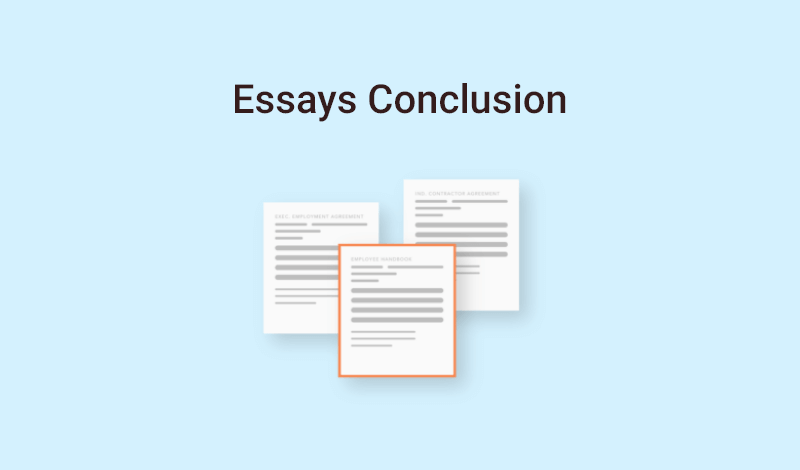
And there you have it.
Essay writing is fun and enjoyable, and it is your mind’s playground where you can let your creativity loose. Plus, since essays are academic pieces, you can also go crazy with your fancy words and no one will really mind.
Hopefully, after reading this post, you’re a little more acquainted with what essays are, what parts they have and how you can write one for yourself the next time you’re required to do so.





